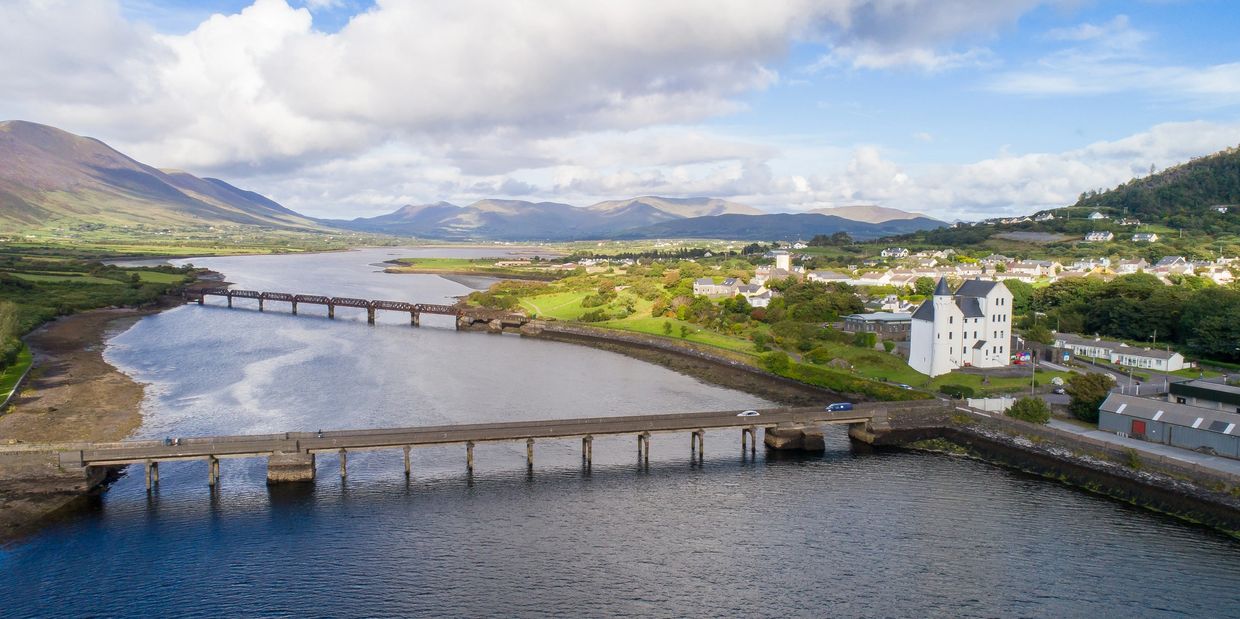Cahersiveen - Ancient Forts and Castles

Cathair Saidhbhin - Little Saidhbh’s Stone Fort
Cahersiveen is the capital town of the Iveragh peninsula. The town lies at the foot of Beentee Mountain, on the Fertha River overlooking Valentia Harbour. Cahersiveen is the main shopping centre for the western end of the Ring of Kerry. From ancient forts and castles to vibrant festivals and breathtaking coastal drives, Cahersiveen offers an authentic Irish experience like no other. It’s a place where history meets adventure, where every path leads to a story, and where the Wild Atlantic Way truly comes alive. Cahersiveen proudly celebrates its connection to Daniel O’Connell, whose efforts in the 19th century secured Catholic Emancipation. His legacy lives on in the town’s culture, architecture, and spirit of resilience.
Cahersiveen has a cosmopolitan flavour, with a superb yachting marina and harbour. The marina has 93 fully serviced berths and sits on the banks of the River Fertha. The Gulf Stream waters of the Atlantic wash through the naturally formed Valentia harbour, creating a safe haven in all weather conditions. Cahersiveen has a reputation for some of the best deep sea angling in Europe and the town’s long sea-faring tradition ensures a deep-rooted understanding of the needs of sailors, and of boats of all types and sizes.

Festivals & Events
The town is a popular spot for nightlife, where you are likely to find a lively traditional music session in any one of the local pubs. One of the highlights of the year is the Cahersiveen Celtic Music Festival held on the August Bank Holiday week-end each year. Another unique event is the annual Christmas swim, which takes place at Cuas Crom. Traditional Fair Days or market days are still held on the streets where people from the surrounding countryside come to shop and socialise. Stall holders set up shop and you can purchase anything from sheep to a wool jumper.

Archaeological Treasures
Cahersiveen is of great importance to antiquarians as it boasts many ancient forts and castles. Take a trip over the bridge north of town to visit the ivy covered ruins of the 15th century Ballycarbery Castle and the two dry stone forts, Leacanabuaile and Cahergal which date to 800 AD. One of the most beautiful views of the river and Valentia Island can be seen from the Gurranebawn Standing Stone. This ancient monolith, located on the high road in Cahersiveen, is believed to date back to the Bronze Age. Its exact purpose remains unknown, but it likely served as a ritual or territorial marker, connecting us to Ireland’s prehistoric past. Standing stones like this are powerful reminders of the deep cultural roots embedded in Kerry’s landscape.
Local Attractions
Cahergal Stone Fort
Cahergal Stone Fort
Cahergal Stone Fort

Situated close to Ballycarbery Castle, this ancient Stone Fort was built around the 7th century. The interior walls have stone stairs and there are two dry stone buildings within the fort – a rectangular house and a beehive hut. Located immediately southeast of the other equally impressive stone fort called Leacanabuile.
Ballycarbery Castle
Cahergal Stone Fort
Cahergal Stone Fort

Just outside town, the ivy-clad ruins of this 15th-century stronghold stand dramatically against the Kerry landscape. Once home to the McCarthy Mór clan, the castle whispers stories of Ireland’s turbulent history. The castle was regularly inhabited up to the time of Queen Elizabeth, but it is understood to have been destroyed by Cromwell in 1652.
The Old Barracks
Cahergal Stone Fort
The Old Barracks

This striking château-style building, originally a Royal Irish Constabulary barracks, now houses exhibitions on local history, the Fenian Rising, and the life of Daniel O’Connell—one of Ireland’s greatest political leaders, born nearby in Carhan. Local legend says the plans for the building originally got mixed up with plans for a building in India.
Daniel O'Connell
Leacanabuile Stone Fort
The Old Barracks

One of Cahersiveen’s most iconic landmarks, this magnificent church is unique—it’s the only Catholic church in Ireland (and one of the few in the world) named after a layperson: Daniel O’Connell, “The Liberator.” Built between 1888 and 1902 using granite and black limestone, the church was designed by G.C. Ashlin and approved by Pope Leo XIII, who even sent a marble slab from the Roman catacombs for its cornerstone. Inside, you’ll find beautiful stained glass and historical relics.
White Strand
Leacanabuile Stone Fort
Leacanabuile Stone Fort

For those who love the sea, the White Strand offers pristine sands and breathtaking views of Valentia and Beginis Islands. It’s a designated Natural Heritage Area and a perfect spot for a refreshing dip or a peaceful stroll. It is one of the many blue flag beaches in the area, recognized for its excellent water quality and high standards of safety and environmental management. During the summer months, lifeguards are on duty.
Leacanabuile Stone Fort
Leacanabuile Stone Fort
Leacanabuile Stone Fort

Its name in Irish means "Hillside of the Milking Place". The ancient fort was excavated in the 1940s and objects including iron knives, pins, bone combs, bronze, millstones and lead were found there. It is immediately northwest of Cahergal for, which was believed to have been linked underground.